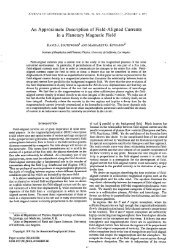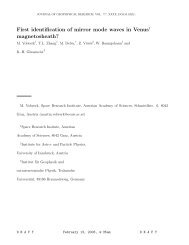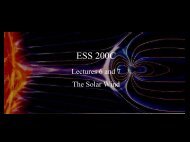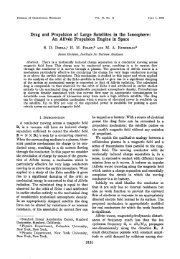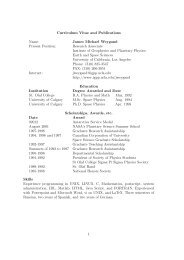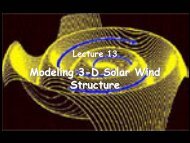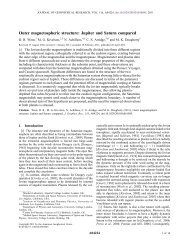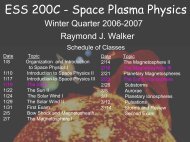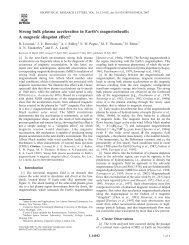Studies of the Magnetospheric Substorm, 3, Concept of the ...
Studies of the Magnetospheric Substorm, 3, Concept of the ...
Studies of the Magnetospheric Substorm, 3, Concept of the ...
You also want an ePaper? Increase the reach of your titles
YUMPU automatically turns print PDFs into web optimized ePapers that Google loves.
JOURNAL OF GEOPHYSICAL RESEARCH, SPACE PHYSICS VOL. 73, NO. 5, MARCH 1, 1958<strong>Studies</strong> <strong>of</strong> <strong>the</strong> <strong>Magnetospheric</strong> <strong>Substorm</strong><strong>Concept</strong> <strong>of</strong> <strong>the</strong> <strong>Magnetospheric</strong> <strong>Substorm</strong> and its Relation to ElectronPrecipitation and MicropulsationsF. V. CORONITI, R. L. MCPHERRON, AND G. K. PARKS 1Department o• Physics and Space Sciences LaboratoryUniversity o• California, Berkeley, California 94720The concept <strong>of</strong> <strong>the</strong> auroral substorm is reviewed in terms <strong>of</strong> recent satellite measurements<strong>of</strong> <strong>the</strong> magnetospheric effects <strong>of</strong> a substorm, and a more general and inclusive terminology, <strong>the</strong>magnetospheric substorm, is suggested. In support <strong>of</strong> this suggestion, it is shown that <strong>the</strong>various forms <strong>of</strong> geomagnetic micropulsations and energetic electron precipitation that havebeen discussed in papers I and 2 occur at <strong>the</strong>ir respective local times during a substorm.Balloon X-ray and micropulsation data obtained by <strong>the</strong> Berkeley group, as well as riometerabsorption, earth currents, and standard magnetograms from several auroral-zone stations,have been used.INTRODUCTIONIn papers I and 2 [Parks et al., 1968; Mc-Pherron et al., 1968, respectively], it was shownthat <strong>the</strong> forms and temporal characteristics <strong>of</strong>energetic electron precipitation an'd micropulsationactivity are determined by <strong>the</strong> local time<strong>of</strong> occurrence. The purpose <strong>of</strong> this paper is topresent evidence that <strong>the</strong>se various types <strong>of</strong>activity do not occur randomly but occur primarflyat times when an auroral substorm[AkasoJ'u, 1964] is in progress. Balloon X-rayand micropulsation data obtained by <strong>the</strong> Berkeleygroup during parts <strong>of</strong> August 1965, and September1966 will be used to show that wheneveran electron precipitation and micropulsationevent occurred, regardless <strong>of</strong> <strong>the</strong> local time <strong>of</strong>observation, an auroral substorm is in someo•bservations [Anderson et al., 1966; Parks et al.,1966], we suggesthat <strong>the</strong> concept <strong>of</strong> <strong>the</strong> auroralphase <strong>of</strong> its development on <strong>the</strong> night side <strong>of</strong> substorm be generalized to, include all <strong>of</strong> <strong>the</strong><strong>the</strong> earth. Standard magnetograms from various associate magnetospheric phenomena. To emauroral-zonestations are used to ascertain <strong>the</strong> phssize this point, we will review some <strong>of</strong> <strong>the</strong>occurrence <strong>of</strong> an auroral substorm. No attempt magnetospheric observations that relate t.o auwillbe made to relate a particular form <strong>of</strong> ener- roral substorms.getic electron precipitation and micropulsation Several correlation studies between magnetotoa specific phase <strong>of</strong> an auroral substorm, nor spheric fields and particles measurements andwill <strong>the</strong> problem <strong>of</strong> possible systematic time auroral disturbances have appeared in <strong>the</strong> recentdelays between stations at different local timesbe discussed.x Present address: School <strong>of</strong> Physics and Astronomy,University <strong>of</strong> Minnesota, Minneapolis,Minnesota 55455.1715MAGNETOSPHERIC SUB STORMBefore presenting <strong>the</strong> observational results,<strong>the</strong> question arises as to <strong>the</strong> appropriate terminologyto describe <strong>the</strong> complicated physicalprocesses occurring in <strong>the</strong> magnetosphere thatproduce an auroral substorm. The concept <strong>of</strong><strong>the</strong> auroral substorm was introduced by Chapmanand Akas<strong>of</strong>u [Akaso)•u, 1964] to describe<strong>the</strong> characteristic disturbed forms <strong>of</strong> <strong>the</strong> aurorasat different times and different longitudesafter <strong>the</strong> breakup <strong>of</strong> <strong>the</strong> auroral arcs aroundlocal midnight. The term substorm indicatesthat auroral disturbances are a fundamentalpart <strong>of</strong> <strong>the</strong> long-lived geomagnetic main phasestorms. In view <strong>of</strong> recent satellite and balloonliterature. Anderson [1965] observed that <strong>the</strong>40-kev electron islands in <strong>the</strong> tail <strong>of</strong> <strong>the</strong> magnetosphereoccurred more frequently duringtimes <strong>of</strong> high Ap. Behannon and Ness [1966]found that <strong>the</strong> magnitude <strong>of</strong> <strong>the</strong> magnetic fieldin <strong>the</strong> taft <strong>of</strong> <strong>the</strong> magnetosphere generally in-
1716 CORONITI, McPHERRON, AND PARKScreases during <strong>the</strong> main phase storm and thatit decreased during a substorm. Heppner et al.[1967] also found that <strong>the</strong> magnetic field in <strong>the</strong>[1965]. Recent observations by Heppner ei al.[1967], however, indicate that <strong>the</strong> physicalprocesses involved in a substorm may be moreregion 10-16 R• decreased after <strong>the</strong> occurrence complicated.<strong>of</strong> a negative bay. Consistent with this evidence,Anderson and Ness [1966] correlated an in-The various forms <strong>of</strong> energetic electron precipitationand geomagnetic micropulsations werecrease in <strong>the</strong> electron island fluxes with a de- shown in papers I and 2 to depend very stronglyerease in <strong>the</strong> tail magnetic field.Ness and Williams [1966] and Williams andNess [1966] observed that <strong>the</strong> collapse <strong>of</strong> <strong>the</strong>high-latitude trapping boundary during magneticstorms was correlated with an increase in<strong>the</strong> magnetospheric tail field. Cahill [1966]showed <strong>the</strong> inner magnetosphere to be inflatedduring a magnetic storm, and large periodic magneticfluctuations were associated with a substorm.Lin and Anderson [1966] also. observedthat hydromagnetic waves attained <strong>the</strong>ir deepestpenetration <strong>of</strong> <strong>the</strong> mqgnetosphere during times<strong>of</strong> high Kp. The dynamics <strong>of</strong> <strong>the</strong> inner magnetospherehave been fur<strong>the</strong>r described by Carpenter[1966], who showed that <strong>the</strong> plasmapausemoved inward when magnetic activity increased.Recently, Carpenter [1967] observed that <strong>the</strong>inward motion <strong>of</strong> <strong>the</strong> whistler duets startedabout 12 minutes before <strong>the</strong> onset <strong>of</strong> a negativebay and interpreted this motion in terms <strong>of</strong> anazimuthal electric field.It is also becoming evident. that substorms areessential in understanding <strong>the</strong> over-all dynamicalprocesses <strong>of</strong> <strong>the</strong> magnetosphere. Fairfieldand Cahill [1966] related <strong>the</strong> north-south component<strong>of</strong> <strong>the</strong> interplanetary an'd transition regionmagnetic field to <strong>the</strong> occurrence <strong>of</strong> auroralzonedisturbances. When a sudden switch to asouthward-directed component <strong>of</strong> <strong>the</strong> magneticfield occurred, an increase in auroral-zone disturbancesfollowed. These results have beensubstantiated by Schatten and Wilcox [1967],who showed that Kp was generally higher when<strong>the</strong> interplanetary magnetic field had a southward-directedcomponent. It is interesting tonote that <strong>the</strong> polar station used by Fairfieldand Cahill in <strong>the</strong>ir analysis showed an almostimmediate increase in <strong>the</strong> disturbance level after<strong>the</strong> switch to <strong>the</strong> southward directed magneticfield component and that <strong>the</strong> associated substormat auroral-zone latitude occurred one totwo hours afterward. This evidence lends supportto <strong>the</strong> field line reeonneetion model for <strong>the</strong>convective magnetosphere proposed by Dungey[1963], Levy et al. [1964], and Axyord et al.on <strong>the</strong> local time at which <strong>the</strong>y were observed.The results to be presented below give strongevidence for <strong>the</strong> fact that <strong>the</strong>se two phenomenaoccur primafly during auroral substorms. It isclear, <strong>the</strong>n, that <strong>the</strong> auroral substorm is part <strong>of</strong>a worldwide disturbance, and that it is <strong>the</strong> dynamicalprocesses occurring throughout <strong>the</strong>magnetosphere that determine <strong>the</strong> local-timecharacteristics <strong>of</strong> <strong>the</strong> substorm. To generalize <strong>the</strong>concept <strong>of</strong> <strong>the</strong> auroral substorm to include all<strong>of</strong> <strong>the</strong> magnetospheric effects, we propose that<strong>the</strong> term magnetospheric substorm be used. Theneed for such a generalization was first pointedout by Jelley and Brice [1967], when <strong>the</strong>y suggeste'd<strong>the</strong> term elementary magnetosphericstorm. More recently, McPherron et al. [1967],Brice [1967], and Parks et al. [1967] suggestedslight modifications <strong>of</strong> this terminology. Brieesuggests elementary magnetospheric substorm;however, because <strong>of</strong> its greater convenience, weurge <strong>the</strong> adoption <strong>of</strong> <strong>the</strong> shorter term, magnetosphericsubstorm.MrTaODOF A•ALYS•STo study <strong>the</strong> relation <strong>of</strong> electron precipitationand magnetic micropulsation activity to <strong>the</strong>magnetospheric substorm, we have examinedevery electron precipitation and micropulsationevent that occurred during five days <strong>of</strong> continuousdata coverage at Flin Flon, Manitoba,Canada, in August 1965. Energetic electron precipitationdata from balloons flown by <strong>the</strong>Berkeley and Sparme> groups an'd riometers,micropulsation data from induction coils andearth currents, and magnetometer data frommagnetograms have been plotted to <strong>the</strong> sametime scale, and combined into correlation plotsfor a single station. Sequences <strong>of</strong> such plotsfrom three widely separated stations were <strong>the</strong>nexamined to determine <strong>the</strong> simultaneous, localtimecharacteristics <strong>of</strong> <strong>the</strong> electron precipitationand micropulsations and <strong>the</strong>ir relation tomagnetospheric substorms. The three stationsand <strong>the</strong>ir geomagnetic coordinates are: FlinFlon, Manitoba (63.6øN, 314.8 ø), College, Alaska
STUDIES OF MAGNETOSPHERIC SUBSTORM, 3 1717(64.6øN, 256.5ø), Kiruna, Sweden (65.3øN,115.6ø).Chart records from Flin Flon containingmicropulsation and X-ray data from September1-9, 1966, and magnetograms from a number <strong>of</strong>auroral-zone stations were also examined todetermine <strong>the</strong> occurrence <strong>of</strong> substorms and <strong>the</strong>local-time characteristics <strong>of</strong> <strong>the</strong> two phenomenaduring substorms.RESULTSFigures 1 and 2 contain energetic electronprecipitation, micropulsation, and magnetometerdata from August 19 to 20, 1965, which was <strong>the</strong>most active part <strong>of</strong> <strong>the</strong> five-day period. In <strong>the</strong>upper portion <strong>of</strong> each figure, large increases inriometer absorption <strong>of</strong> X-ray fluxes indicate<strong>the</strong> occurrence <strong>of</strong> electron precipitation events.In <strong>the</strong> center, <strong>the</strong> amplitude and frequency <strong>of</strong>BALLOONzz. K I;5 / 65FLIGHT•- z I FLIN FLON•0, n- • RIOMETER • II FLIGHT 514L• • (CHURCHILL)zo I -I t/EeUENCII• • I J • I ; •t,", • ./I•L AMPLITUDE0 ',•'-5 " ' ,I •'• "I• FF A} •COL KIR FF• 0600 I• 18•UNIVERSALTIME•ig. 1. •]eetron precipitation, micropu]sation, gn• mggnetometet dg{g at {hree aurorg]-zone•tions, August 19, 1965.
1718 CORONITI, McPHERRON, AND PARKS.,1:•KIRUNABALLOON FLIGHT j•J/JI• J J•, IVALO.BALLOONFINLANDFLIGHTl,-- I I I I InZ •,J'• FLIN FLON BALLOON• ,.FLIGHT 514 L• I I'' I I I ' Iz , , ,-,,,,.,. ,.,,, k l,",l'"""•,.-•,i.1,,,.,, ,..,",: ,.,.,, ,,v, .',,,.:,•,-.-g7',,o........,,. ,?v¾,"" /7'TM......",,:•.,,,•,,,".,'.,I I I I I I ,,,. T+HF• COLI I0000 0600 1200 1800 2400UNIVERSALTIMEFig. 2. Electron precipitation, micropulsation, and magnetometer data at three auroral-zonestations, August 20, 1965.micropulsations at Flin Flon are plotted. Themicropulsation data from College and Kirunaconsisted <strong>of</strong> slow-speed earth current recordings.Therefore, it was not possible to make quantitativescalings for <strong>the</strong>se records. However, <strong>the</strong>occurrence and general character <strong>of</strong> micropulsationevents at <strong>the</strong>se stations can be recognizedin <strong>the</strong> original data and were found to be inaccordance with Figure 13 <strong>of</strong> paper 2. In <strong>the</strong>bottom <strong>of</strong> each figure, magnetograms from <strong>the</strong>three stations are superimposed to show <strong>the</strong>occurrence <strong>of</strong> substorms.A. 1500 UT, August 19, 1965. The significance<strong>of</strong> <strong>the</strong> following observations is betterunderstood when <strong>the</strong> geographic positions <strong>of</strong><strong>the</strong> three stations are considered. Figure 3 shows<strong>the</strong>ir locations at 1500 UT; College was near0500, Flin Flon at 0800, and Kiruna at 1600local time.Figure I shows a strong negative bay at Col-
STUDIES OF MAGNETOSPHERIC SUBSTORM, 31719NOON!i!!!iiii!iiiiiiiiiiiiiii!:'i::::iii::iiiiZO..NEiiiiiii:.. ........................MIDNIGHT(LOCAL TIME)Fig. 3. Position in local time <strong>of</strong> various auroralzonestations at 1500, UT.begin to rise about this time. Energetic electronprecipitation began sharply at 0515 UT andhad no evident structure. At 0640 UT an impulsiveelectron precipitation event (first largespike in Flin Flon balloon data) was accompaniedby a weak noise. A second impulsiveelectron precipitation event occurred (see secondspike in Flirt Flon Balloon data) at 0735UT, in conjunction with a very strong noiseburst. Sudden changes in both <strong>the</strong> Flirt Flonand Collage magnetograms at this instant indicatethis is <strong>the</strong> beginning <strong>of</strong> <strong>the</strong> expansionphase <strong>of</strong> <strong>the</strong> associated auroral substorm. Thisinterpretation is verified .by an examination <strong>of</strong><strong>the</strong> magnetogram from a station at Baker Lake,which is considerably north <strong>of</strong> Flin Flon. Thismagnetogram (not shown) recorded <strong>the</strong> firstmagnetic disturbance at 0740 UT. In particular,<strong>the</strong> characteristic feature <strong>of</strong> this disturbancewas a rapid increase in <strong>the</strong> vertical component,which was just <strong>the</strong> disturbance expected for awestward line current moving northward towardBaker Lake. Coincident with noise burst at0735 UT, band-limited pulsations began to berecorded at Flin Flon. This was evident fromlege at 1400 UT indicating that an auroralbreakup occurred over central Russia. No significantdisturbance was evident on <strong>the</strong> FlinFlon or Kiruna magnetogram. The electron precipitationassociated with this substorm occurredfirst at College, <strong>the</strong>n .at Flin Flon, and later atKiruna. The electron precipitation at Flirt Flonwas modulated with a 10-sec perio'd and hadoccasional microburst groups. An examination<strong>of</strong> <strong>the</strong> riometer records from College and riometerand X-ray data from Kiruna shows that<strong>the</strong> rapid increase in frequency <strong>of</strong> <strong>the</strong> Flin Flonmicropulsation that began at this time. At 0820UT, <strong>the</strong> micropulsations reached a peak in frequencycorresponding to a 10-sec period, andmodulated electron precipitation began wi<strong>the</strong>ssentially <strong>the</strong> same perio'd. About 90'00 UT a<strong>the</strong> electron precipitation was <strong>of</strong> worldwide extent.Somewhat earlier at 1400 UT a large-NOONamplitude, high-frequency micropulsation eventibegan at Flirt Flon and was <strong>of</strong> <strong>the</strong> band-limitedirregular type described in paper 2. The Col-Il•ge earth currents show a high-frequencymicropulsation event that coincided in time with<strong>the</strong> one at Flin Flon. No micropulsation activitywas evident in <strong>the</strong> Kiruna earth currents.B. 0500-1500 UT, Augusi 20, 1965. Thegeographic location o.f <strong>the</strong> three stations interms <strong>of</strong> local time for this event is shown'inDUSKNFigure 4. The arrow indicates <strong>the</strong> region <strong>of</strong> local0500 UTtime through which each station rotates during<strong>the</strong> event.An examination <strong>of</strong> <strong>the</strong> Flirt Flon data (Figure2) shows a close relationship between all threerecords. The ionospheric currents eventuallyresponsible for a large negative bay first causedMIDNIGHT( LOCAL TIME)a magnetic disturbance at Flirt Flon zbout 0500. Fig. 4. Position in local time <strong>of</strong> various auroral-The micropulsation amplitude and frequenc. yzone stations at 0500 UT.
1720 CORONITI, McPYIERRON, AND PARKSsecond substorm apparently began before <strong>the</strong>first substorm was completely recovered. Theexpansion phase <strong>of</strong> this substorm appeared tooccur between 1015 and 1045 UT during which<strong>the</strong> Flin Flon magnetometer reached a maximumnegative excursion in H component.Again, this interpretation was verified by anincrease in <strong>the</strong> vertical component at BakerLake. During this second substorm, only occasionalfluxes <strong>of</strong> electrons were observed atFlin Flon, and a second band-limited irregularevent occurred. About 1130 to 1145 UT a noisewith large sequences <strong>of</strong> very regular 10-see pulsations.Band-limited irregular micropulsations<strong>of</strong> similar period were still present.Simultaneous balloon X-ray data for thisevent from Kiruna have been published by <strong>the</strong>Sparmo group [Eh•ert et al., 1966]. The X-raydata for August 19-20, when available, havebeen plotted in place <strong>of</strong> <strong>the</strong> Kiruna riometer.At 0400 UT, August 20, a silght increase inX-ray flux was observed at Kiruna and reacheda peak at 0500 UT. It should be noted that <strong>the</strong>onset time and <strong>the</strong> time <strong>of</strong> maximum X-ray intensityat Flin Flon and Kiruna were <strong>the</strong> same.From 0800-1000 UT, a large flux <strong>of</strong> X rays weredetected at Kiruna. This period corresponded to<strong>the</strong> recovery phase <strong>of</strong> <strong>the</strong> first substorm andcoincided with <strong>the</strong> detection <strong>of</strong> large X-rayfluxes at Flin Flon. No indication <strong>of</strong> electronprecipitation was recorded in <strong>the</strong> College riometeruntil <strong>the</strong> beginniag <strong>of</strong> <strong>the</strong> second substorm,during which low-level electron fluxeswere observed simultaneously at all three stations.The most striking confirmation <strong>of</strong> <strong>the</strong> worldwideextent <strong>of</strong> <strong>the</strong> electron precipitation isdemonstrated by <strong>the</strong> third substorm. Large electronfluxes were observed simultaneously over12 hours <strong>of</strong> longitude beginning at about 1200UT. Electron precipitation begins first at Collegeand <strong>the</strong>n almost simultaneously at FlinFlon and Kiruna. Band-limited irregular micropulsationswere recorded at Flin Flon throughout<strong>the</strong> entire period 0800-1400 UT (2-8 localtime). They were also observed at College during<strong>the</strong> third substorm, when College finallyrotated into <strong>the</strong> local time interval 0200-1000.This type <strong>of</strong> micropulsation was not recordedat Kiruna, since Kiruna had passed beyon'd <strong>the</strong>appropriate local-time interval by <strong>the</strong> time <strong>the</strong>first substorm reached maximum development.OBSERVATIONS FROM SEPTEMBER 1-9, 1966burst was recorded that preceded <strong>the</strong> beginning<strong>of</strong> a third substorm. It appears that noise burstsare a characteristic feature in <strong>the</strong> development <strong>of</strong>an auroral substorm. (This concept is beingexamined in more detail, and <strong>the</strong> results will bereported in a later publication). The expansionphase <strong>of</strong> this third substorm began about 1225UT as shown 'by <strong>the</strong> sudden enhancement <strong>of</strong> anegative bay at College. The electron precipi-Simultaneous balloon X-ray and micropulsationdata obtained at Flin Flon from September1-9, 1966, were compared with standard magnetogramsfrom several stations to fur<strong>the</strong>rexamine <strong>the</strong> relationship. <strong>of</strong> electron precipitationand micropulsations to <strong>the</strong> magnetosphericsubstorm. The results <strong>of</strong> this analysis show thatevery micropulsation and electron precipitationevent duriag this time occurred when a magtationstarted at 1230 UT and was modulated netospheric substorm was in progress somewhereon <strong>the</strong> night side and confirm <strong>the</strong> relationshipsfound in Figures 1 and 2 to holdgenerally. The temporal characteristics <strong>of</strong> <strong>the</strong>electron precipitation and micropulsations and<strong>the</strong> local time at which <strong>the</strong>y were observed atFlin Flon are noted and agree with <strong>the</strong> localtimeoccurrence patterns presented in papers1 and2.CONCLLISIONHaving shown in papers 1 and 2 that whenelectron precipitation and micropulsations occurat a given local time, <strong>the</strong>y possess distinct temporalcharacteristics for each local time, evidencewas presented in this paper that <strong>the</strong>setwo phenomena occur almost simultaneouslythroughout <strong>the</strong> auroral zone during an auroralsubstorm. Aka•o]u [1964] showed that at differentphases <strong>of</strong> <strong>the</strong> substorm and at differentlongitudes, <strong>the</strong> physical appearance and temporalcharacteristics <strong>of</strong> <strong>the</strong> auroral forms possessedwell-defined structures and occurrencepatterns. Even though simultaneous balloon X-ray and micropulsation experiments from manydifferent stations have not been performed from<strong>the</strong> established local time occurrence patternand <strong>the</strong> relationship to <strong>the</strong> substorm that wasdemonstrated above, it can be concluded thateach specific form <strong>of</strong> energetic electron precipitationand micropulsation is probably occurring
STUDIES OF MAGNETOSPHERIC SUBSTORM, 3 1721at its respective local time during some phase<strong>of</strong> <strong>the</strong> substorm development.The fact that <strong>the</strong> occurrence <strong>of</strong> an auroralsubstorm is present, not only in auroral disturbanees,but also in electron precipitation andmicropulsation activity throughout <strong>the</strong> auroralzone, indicates that it is <strong>the</strong> dynamical processesoccurring in <strong>the</strong> magnetosphere that determine<strong>the</strong> local-time characteristics <strong>of</strong> <strong>the</strong> substorm.Recent satellite observations have shown thatmany magnetospheric phenomena are correlatedwith substorms. To generalize <strong>the</strong> concept <strong>of</strong> <strong>the</strong>auroral substorm to. include <strong>the</strong> worldwide disturbaneecharacteristics and to emphasize <strong>the</strong>importance <strong>of</strong> <strong>the</strong> magnetosphere in auroralzoneobservations, we have suggested <strong>the</strong> term,magnetopsherie substorm.Acknowledgments. We would like to thankboth Pr<strong>of</strong>essor K. A. Anderson and Pr<strong>of</strong>essorR. R. Brown for <strong>the</strong>ir interest and advice givenin many helpful discussions.This research was supported by <strong>the</strong> NationalAeronautics and Space Administration undergrants NsG-243 and NsG-387; <strong>the</strong> National ScienceFoundation under grants GP-5583, GP-5331,and GA-734, and <strong>the</strong> Office <strong>of</strong> Naval Researchgrant Nonr 222(89).REFEREI•CESAkas<strong>of</strong>u, S.-I., The development <strong>of</strong> <strong>the</strong> auroralsubstorm, Planetary Space Sci., 12, 273, 1964.Anderson, K. A., Energetic electron fluxes in <strong>the</strong>tail <strong>of</strong> <strong>the</strong> geomagnetic field, J. Geophys. Res.,70, 4741, 1965.Anderson, K. A., L. M. Chase, H. S. Hudson, M.Lampton, D. W. Milton, and G. K. Parks,Balloon and rocket observations <strong>of</strong> auroral-zonemicrobursts, J. Geophys. Res., 71, 4617, 1966.Anderson, K. A., and N. F. Ness, Correlation <strong>of</strong>magnetic fields and energetic electrons on <strong>the</strong>IMP I satellite, j. Geophys. Res., 71, 3705, 1966.Axford, W. I., H. E. Petschek, and G. L. Siscoe,Tail <strong>of</strong> <strong>the</strong> magnetosphere, J. Geophys. Res., 70,1231, 1965.Behannon, K. W., and N. F. Ness, Magneticstorms in <strong>the</strong> earth's magnetic tail, J. Geophys.Res., 71, 2327, 1966.Brice, N., Morphology <strong>of</strong> elementary magnetospheriesubstorms, Conjugate Point Symposium,June 1967, Boulder, Colorado, p. IV-12-1, 20,ITSA Mem. 72, July 1967.Cahill, L. J., Jr., Inflation <strong>of</strong> <strong>the</strong> inner magnetosphereduring a magnetic storm, J. Geophys.Res., 71, 4505, 1966.Carpenter, D. L., Whistler studies <strong>of</strong> <strong>the</strong> plasmapausein <strong>the</strong> magnetosphere, 1, Temporal variationson <strong>the</strong> position <strong>of</strong> <strong>the</strong> knee and someevidence on plasma motions near <strong>the</strong> knee, J.Geophys. Res., 71, 693, 1966.Carpenter, D. L., Direct detection by a whistlermethod <strong>of</strong> <strong>the</strong> magnetospheric electric fieldassociated with a polar substorm, PlanetarySpace Sci., 15, 395, 1967.Dungey, J. W., Interactions <strong>of</strong> solar plasma with<strong>the</strong> geomagnetic field, Planetary Space Sci., 10,233, 1963.Ehmert, A., G. Kremser, G. Pfotzer, K. H. Sarger,K. Wilhelm, W. Rideler, A. Brewersdorfi J.P.Legrand, M. Palous, J. Oksman, and P. Tanskanen,Simultaneous measurements <strong>of</strong> auroralX-rays at Kiruna (Sweden) and Ivalo/Sodankyl•i(Finland) from July to September, 1965,Sparmo Bull. 2, 19'66.Fairfield, D. H., and L. J. Cahill, Transitionregion magnetic field and polar magnetic disturbances,J. Geophys. Res., 71, 155, 1966.Heppner, J.P., M. Sugiura, T. L. Skillman, B. G.Ledley, and M. Campbell, OGO-A magneticfield observations, Goddard Space Flight Centerpubl. X-612 67-150, 1967.Jelley, D. H., and N. Brice, Association betweenincreased radiation in <strong>the</strong> outer belt and polarauroral substorms (abstract), Trans. Am. Geophys.Union, 48, 180, 1967.Levy, R. H., H. E. Petschek, and G. L. Siscoe,Aerodynamic aspects <strong>of</strong> <strong>the</strong> magnetosphericflow, AIAA J., 2, 12; 1964.Lin, R. P., and K. A. Anderson, Periodic modulations<strong>of</strong> <strong>the</strong> energetic electron fluxes in <strong>the</strong>distant radiation zone, J. Geophys. Res., 71,1827, 1966.McPherron, R. L., G. K. Parks, and F. V. Coroniti,Relation <strong>of</strong> Correlated magnetic micropulsationsand electron precipitation to <strong>the</strong>auroral substorm, Conjugate Point Symposium,June 1967, Boulder, Colorado, p. 111-4-1, 15,ITSA Mem. 72, July, 19'67.McPherron, R. L., G. K. Parks, F. V. Coroniti,and S. H. Ward, <strong>Studies</strong> <strong>of</strong> <strong>the</strong> magnetosphericsubstorm, 2, Correlated magnetic micropulsationsand electron precipitation occurring duringauroral substorms, J. Geophys. Res., 73(5), 1968.Ness, N. F., and D. J. Williams, Correlated mag-netic *• and r•rdiation belt o•scrvadons, •' •' •. •Geophys. Res., 71, 322, 1066.Parks, G. K., F. V. Coroniti, R. L. M ePherron,and K. A. Anderson, Stu. dies <strong>of</strong> <strong>the</strong> magnetospheriesubstorm, 1, Characteristics <strong>of</strong> modulatedenergetic electron precipitation during auroralsubstorms, J. Geophys. Res., 73(5), 1968.Parks, G. K., R. L. MePherron, and K. A. Ander-son, Relation <strong>of</strong> 5- to 40-second-period geomagneticmicropulsations and electron precipitationto <strong>the</strong> auroral substorm, J. Geophys. Res., 71,5743, 1960.Parks, G. K., R. L. MePherron, and F. V. Coroniti,Relation <strong>of</strong> energetic electron precipitationand geomagnetic micropulsations to auroral substorms,paper presented at <strong>the</strong> Birkland Sym-
1722 CORONITI, McPttERRON, AND PARKSposium, Norway, September 1967 (to be publishedin Ann. Phys.)Schatten, K. H., and J, M. Wilcox, Response <strong>of</strong><strong>the</strong> geomagnetic activity index K• to <strong>the</strong> interplanetarymagnetic field, J. Geophys. Res., 72,•i185, 1967.Williams, D. J., and N. F. Ness, Simultaneoustrapped electron and magnetic tail field observations,J. Geophys. Res., 71, 5117, 1966.(Received August 4, 1967;revised November 29, 1967.)



